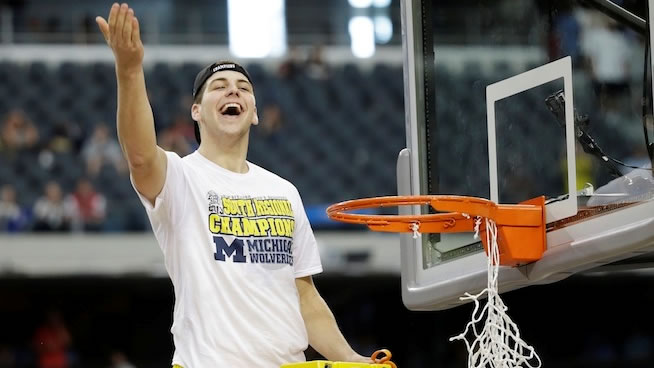| The Architect: How University of Michigan's Jon
Provided by - Stack.com
Bob Marley's “No Woman No Cry,” playing soft and mellow, floats through the speakers as members of the University of Michigan basketball team file into the weight room. It's a Thursday afternoon, just four days before a showdown against Michigan State that will eventually decide the Big Ten title; but the atmosphere is loose and upbeat. Players laugh and tell jokes as they take turns stepping onto a scale, every weight recorded on a sheet for the man behind the glass window to analyze. That man—tall and imposing with a hint of white at the chin of his orange-brown beard—is Jon Sanderson, a former college basketball player at Ohio State who is in his fifth season as the head strength and conditioning coach at Michigan. From his desk, Sanderson can see almost every inch of the 5,500-square foot weight room, and the vast expanse of the team's practice courts is visible through the window to his right. Easy visibility is just one of the many advantages conferred by Michigan's two-year old Player Development Center (PDC), a twenty-three million dollar training facility that Sanderson had a big hand in designing. As the last player strides in, Sanderson walks out of his office and toward his group of players, the majority of whom are underclassmen. He says a few quiet words, and the team breaks into two groups. As the players stretch out on foam rollers, Sanderson looks up at the speakers, where the relaxing reggae music continues to play, and says, “This isn't going to work.” He disappears back into his office, and soon Big Sean replaces Marley as the soundtrack. The rap music plays quietly enough for the players to hear Sanderson's instructions as they move from exercise station to exercise station. Players hurl medicine balls at a wall that has every one of Michigan's Big Ten opponents painted on as targets, while other Wolverines perform Planks on foam pads nearby. Sanderson cues the music to play louder, and the volume increases as the players launch into their big lifts—Squats, Cleans and Shrugs. Players nod their heads to the beats, and Big Sean drowns out Sanderson, who resorts to clapping to encourage players as he weaves among the athletes in front of him. Sanderson steps in front of Glenn Robinson III, a future NBA draft pick, and pauses. This weight room didn't exist before Sanderson arrived. Neither did these players' bodies, at least not in the muscled-up, toned way they look today. Building the Big Ten Player of the Year
During his first two years at Michigan, Sanderson had a second job in addition to his regular duties of training the players. Working under Mike Favre, director of the Olympic Sports Strength and Conditioning Department and a man whom Sanderson considers his mentor, Sanderson collaborated with architects to develop the weight room in the new PDC. The original plans called for 2,200 square feet, but Sanderson told them he needed more space—way more. The PDC weight room today is nearly twice that size. “When you get an opportunity like that, you just make it happen,” Sanderson says. “You have to be creative with your time. I remember doing [the planning] on road trips and on flights, bus rides on the way to the arena. I always had carbon paper on me.” When the PDC opened in early 2012, Sanderson had a facility that rivaled those of any top program in the country. Just four teams use the weight room: men's and women's basketball and men's and women's golf, since the two sports have different training seasons. In effect, Sanderson has all the space and time he needs. Sanderson's training has been an integral part of player development since he arrived, but it gained national attention after Michigan made the Final Four last year—the first time the Wolverines had done so since 1993. The spotlight on the program made it much easier for people to notice three incredible athlete transformations that Sanderson helped facilitate. Following the team's loss to Louisville in last year's National Championship game, Michigan's two starting sophomore guards, Nik Stauskas and Caris LeVert, stayed in Ann Arbor to train with Sanderson. Although every Wolverine is required to come for summer term, Stauskas and LeVert got an extra seven weeks of work in with Sanderson by not going home for the spring term. The results were immediately clear to anyone who saw the athletes when the fall semester started. Stauskas, who had arrived in Ann Arbor as a 192-pound freshman, started the season at 208. He had also added more than 5 inches to his max vertical jump, elevating from 11'3 to 11'8-1/2. LeVert grew from 162 to 190 pounds and adding 6 inches to his vertical, from 11'1-1/2 to 11'7-1/2. “Within the first couple weeks of really working with [Sanderson], you start to see the results,” Stauskas says. “Once you see the results, it just makes you want to go even more. It was after two or three weeks into the spring, I remember looking into the mirror and already starting to notice a difference.” Sanderson started the athletes in April with two three-week “general prep” phases—high reps, moderate weight. During this period, they grinded out sets of eight to 12 reps with short rest intervals, performing exercises like Squats, Cleans, and Shrugs. But Sanderson didn't focus solely on building straight muscle. He placed equal emphasis on speed through exercises like Plyometrics and Bench Press-to-Clap Push-Ups. After building the foundation during general prep, the athletes moved into a “basic strength” phase of four to six reps using heavier weights. By the end of summer, they were prepped to challenge themselves and measure their one-rep maxes. “If you prepare an athlete properly and have a scientifically mapped out plan, they are going to do well and be prepared, and it's going to be safe,” Sanderson says. “When you just have a random approach and say, 'Ah, let's just test next Tuesday,' bad things happen. It needs to be planned out.” Playing with more strength and power, the two guards led Michigan in scoring this season, averaging almost 31 combined points per game. Stauskas, who was once viewed as just a shooter, was named Big Ten Player of the Year. Sanderson directed an equally impressive athlete transformation in the team's behemoth center, Mitch McGary. Early in his freshman year, the then-270-pound McGary was unable to play more than 12 to 15 minutes per game. But during winter break of that season, the 6-foot-11 McGary cut down to 255 pounds, using non-impact exercises in the pool and on the bike, and performing battle rope circuits and versa climber workouts to slim down without pounding his body.
The weight loss was so impactful that McGary played a career-high 36 minutes in the 2013 national semifinal against Syracuse and was named to the All-Final Four team. He was named a pre-season All-American this year, before his sophomore season was cut short by back surgery in December. “We had a greater emphasis on nutrition [with McGary], because the kid can eat,” Sanderson says. “Caris and Nik can get away with it, but Mitch could be a WWE superstar. He's like the Undertaker. He's a big, physical guy, who could be a massive human being. We could get him to 300 pounds and under 10 percent body fat if we really wanted him to get there. He's that special of an athlete.” The key to all of this—whether for McGary, Stauskas, LeVert or a walk-on—is Sanderson's attention to detail. Every lift that a player does is recorded, as is every pound added or dropped. Nothing goes uncharted, so every workout falls within a specific range, depending on the athlete. The result is a basketball program whose players are not afraid to train heavy. Big lifts are not unheard of, because of the precise and scientific approach taken to every lift before the max one. “You have to be consistent,” Sanderson says. “That's why we track everything [players] do, because if we're going to do a Power Clean or a Squat in-season, I want to know exactly what they did. I could tell you every single set that every single one of our guys has done this season. Before I let a kid squat 300 pounds, I'm going to look and see what he did last Wednesday. What if you only did 225 the week before? I don't want to have that much of a jump. So I'm always tweaking. I give all our guys a range for them to stay in, even if we're doing a Bench Press; there's a range and they stay in that maintenance range. There's a recurring theme of planning using scientific methodologies. It's not random stuff.” Changing Times When Sanderson played in the late 1990s, lifting was never a part of his team's regular routine. A month or more might pass between strength sessions, and when they did happen, they were often a response to a bad performance by the team. “Fifteen years ago, lifting wasn't the norm,” Sanderson says. “The thing that usually sparked the last lift was, ‘We got out-rebounded last night, let's get them back in the weight room.' That was the old-school mentality.” Now, nearly two decades later, nothing in Sanderson's program is random. Michigan's basketball team has performed strength work at least once a week, every week, for the five years Sanderson has been in Ann Arbor. More than 250 weeks have come and gone, and neither games nor tournaments nor breaks from school have prevented the team from lifting. When Sanderson finishes the 30-minute workout with his team before practice, he heads back to his office. Big Sean still plays in the background as he turns his attention to his spreadsheets and numbers. He needs to work quickly. Players will soon be back in the weight room for a 15-minute post-practice lift. By that time, Sanderson will have every exercise planned down to the minute, and every lift down to the pound. The architect won't leave any chance of inconsistencies. Sample Training Day for University of Michigan Basketball Pre-Practice Lifting The goal of the pre-practice lift is to have the athletes feeling potentiated, warmed up and primed for practice, and it focuses on the lower body. Before practice is the best time for players to lift big during the season, Sanderson says. “If you try to get a kid to squat or something heavier in nature after practice, it's absolute garbage. They have a hard time because of the fatigue of practice; but before, they aren't fatigued and it actually helps their practice, assuming the volume is low." By “volume,” Sanderson means the number of sets and reps (not the sound of Big Sean coming through the PA.) The coach usually prescribes five or six sets of single or double reps (about 10 reps total), in a workout structured as follows:
One might think heavy lifting could tire athletes out, but Sanderson says the opposite is true. “When these kids move some weight around, they feel great going into practice. They'll go down there like jumping jacks. If Glenn [Robinson III] puts 300 pounds on his back, just for a single, not high reps, he'll go down there prepared to move 500 pounds. If you think he's a dunk machine in games, you should see him in some of our practices when he's feeling good.” Post-Practice Lifting Following team practice, the Wolverines focus on upper body and core work, performing a 15-minute circuit that includes:
|










